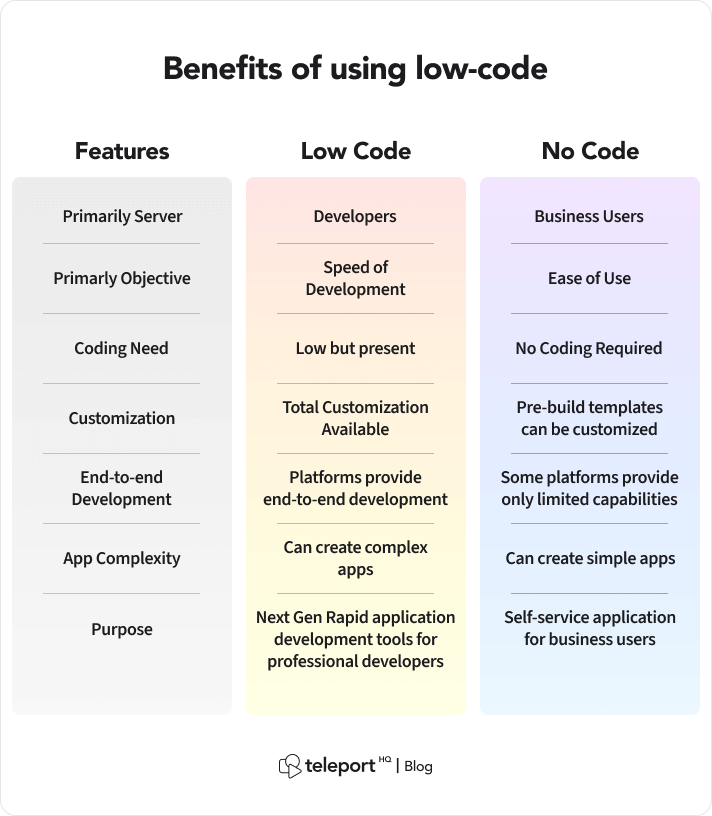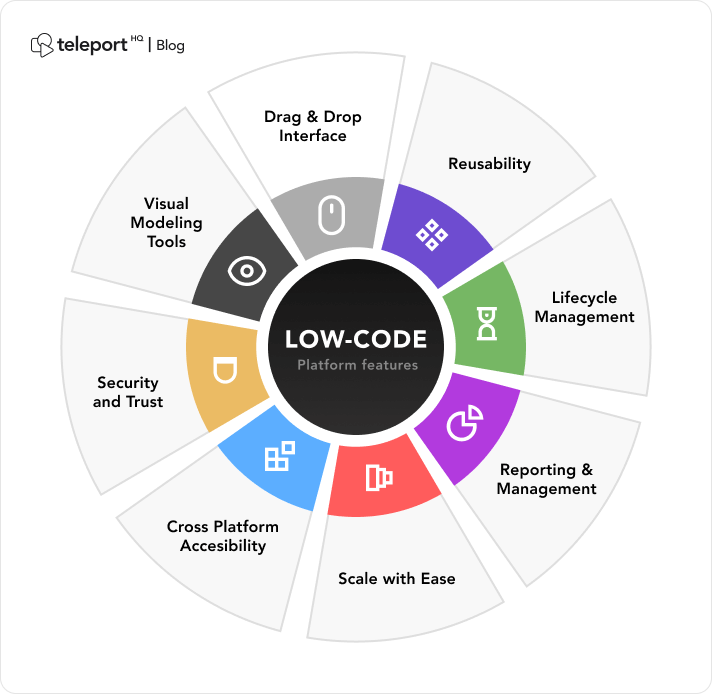Best Tips To Selecting Low-Code Platform Examples
Best Tips To Selecting Low-Code Platform Examples
Blog Article
The Benefits Of Low-Code Development To Speed Up Development
Visual Development Environment:
Drag-and-Drop Interfaces: Low-code platforms provide visual tools for designing applications. Developers can utilize drag-and-drop tools to build applications quickly without writing a large amount of code.
Pre-built components and templates Low-code platforms come with pre-built components as well as templates, which allows developers to quickly build prototypes and build applications.
Reduced Coding Requirements:
Automated Code Generation Low-code platforms automatically generate the code that is used to build the visual models developed by programmers. This reduces the need for manual code coding and improves the speed of development.
Reusable Parts: Developers will have the ability to reuse reusable parts across projects and reduce the time required for writing and testing code.
Streamlined Collaboration:
Low-code platform tools usually include versions control, testing deployment. This allows for the seamless communication between teams.
Citizen Development - Business users, non-developers and other stakeholders are able to help in the creation of applications through user interfaces that are intuitive. This eliminates the bottleneck caused by lack of availability of professional developers.
Rapid Iteration & Prototyping
Rapid Prototyping Developers can swiftly develop prototypes to allow ideas to be tested and feedback gathered which results in faster iteration.
Easy Modifications: The visual nature of low-code development makes it easier to make updates and changes to applications, which speeds up the process of improving and refining applications based on feedback from users.
Pre-built Integrations:
API Integrations: Low-code platforms typically come with connectors for popular services and APIs. This reduces the time required to integrate external systems.
Data integration tools: Tools for data integration are included to help simplify the process.
Deployment Scaling
A lot of low-code platforms offer an option to deploy applications in one click, which reduces the amount of time and effort required to deploy applications.
Cloud-Based Solution: Cloud based low code platforms can handle the management of infrastructure and scale. This allows developers to concentrate on application logic, functionality and features, rather than deployment logistics.
All in all, low-code development offers the advantage of speed because of its capability of automating and simplifying many elements of development. This allows for quicker delivery of apps and easier adaptation to changing needs. Have a look at the top rated the full details about Low-code Platform for application development for site tips including develop web app, develop web application, application modernisation, jdbc server, multiplatform mobile app development, build with docker, application development platforms, paas service, rapid application design, stored sql procedures and more.
Benefits Of Low-Code Application Development In Terms Of Scalability And Flexible
Low-code application development offers a variety of advantages, including scalability and flexible application design. These are essential in creating apps that adapt to changing needs and evolve with the company. Here are a few key benefits.
Cloud-based deployment: A lot of low-code platforms are built. This lets applications grow seamlessly in tandem with the cloud infrastructure. This lets companies handle increasing loads without worrying over the management of servers.
Auto-Scaling: The auto-scaling function allows you to automatically adjust resources based on demand. This will ensure constant performance during peak times, without any manual intervention.
Flexible Architecture:
Modular Design: Low-code systems support modular application design, which means that components can be created independently test, scaled, and then redesigned. This flexibility increases the flexibility of an application and makes it simpler to expand or update specific elements of a program without affecting the overall system.
Integration of microservices: The support offered by the microservices architecture lets applications be designed as a collection of loosely coupled services. This improves scalability, and flexibility.
Customizable Solutions:
Flexibility : Low-code platforms permit developers to expand functions beyond what they are able to provide. This allows for unique business needs to be met with no limitations.
Third-Party Integrations: The integration of APIs, third-party services or other services allows companies to enhance the functionality of their application by adding additional functionalities.
Agile Development and Deployment
Continuous delivery and deployment Low-code platforms can be used with agile methodologies and enable continuous integration and delivery (CI/CD). This allows for rapid deployment and update of features.
Iterative Development - The low-code method lets applications be upgraded and scaled gradually which lowers risk and allows for more controlled expansion.
Resource Optimization:
Effective Resource Management: Low Code platforms can maximize resource utilization by using tools that track and control the performance of an application. This helps ensure that resources are used efficiently and can be scaled either up or down depending on actual demands.
Load balancing: The application can handle high traffic easily and consistently thanks to the integrated load-balancing features.
Global Reach
Multi-Region Accessibility: Lowcode platforms allow to be used across a variety of regions. Businesses can offer users low-latency worldwide access. This is crucial when it comes to applications that target a global audience.
Support for Localization. Built-in support to localize applications lets them be easily adjusted to various languages, regional requirements and increases their flexibility across diverse markets.
Maintenance and updates
Low-code software is visually appealing and are modularly built, making it easier to perform maintenance. Updates or bug fixes can be made quickly and without extensive downtime.
Version Control Systems for Controlling Versions will help you manage updates, rollbacks and other changes. They can assure that the changes can be released in a safe manner and that previous versions can be restored when necessary.
Cost Efficiency:
Low Development Costs. By reducing coding requirements, low-code platforms cut down on the cost of development and allow applications to grow without requiring more development efforts.
Pay-As-You Go Models: A lot of low-code platforms provide flexible pricing models, like pay-as-you-go, which align costs with usage and growth, providing the flexibility to finance.
The flexibility of low-code apps allows businesses to develop robust and flexible, scalable and robust applications. These platforms allow for quick changes to the demands of changing times as well as efficient utilization of resources and constant improvement, which ensures that the application can develop and grow to meet the needs of the business. Have a look at the top rated great site on Enterprise application development with Low-code Platform for site info including cross platform mobile app development, azure sql server, cross platform app development, app modernization, application modernisation, database in azure, low code development platforms, app modernisation, rapid action development, developing mobile apps and more.
Benefits Of Low Code Application Development In Terms Of Specifications And Customization
The low-code approach offers an unbiased method that permits substantial customization and overcomes limitations. Here are some of the key benefits.
In overcoming Complexity Barriers:
Low-code platforms make development easier by providing pre-built templates and components. This facilitates rapid deployment and development of complex applications.
Guided Workflows: A lot of platforms have guided workflows as well as wizards to help developers navigate through complex processes, reducing the likelihood of errors and guaranteeing consistency.
Scalability Solutions:
Built-In Scalability: Low-code platforms often include features that support an scalable architecture, which allows apps to take on more load without requiring significant changes.
Performance Monitoring Performance Monitoring Tools: Integrated performance monitoring tools and optimization tools ensure that applications are as efficient as they can be, no matter their scale.
Security and Compliance:
Integrated security features: Low-code platforms have security measures like encryption, role-based control of access, and automated compliance checking, which address common security issues.
Platforms are regularly changing their security procedures and methods of compliance, which guarantee that applications are safe from new threats.
Customization Options:
Extensibility:
Custom Code Integration : Low-code platforms typically allow for the integration of customized code (e.g. JavaScript, Python) that allows developers to extend the functionalities beyond the standard offerings.
Customized plugins and modules: Developers can create customized plugins or modules that provide specific features that are adapted to unique business requirements.
APIs and Integration
API Support: Comprehensive APIs support is available to facilitate seamless integration and connection to external systems.
Third-Party Services: Low code platforms have connectors designed to work with popular third party services. This makes it easier to customize and integrate applications.
Flexible UI/UX design:
Customizable Interfaces: Developers have the ability to design and customize user interfaces in line with specific usability and branding criteria and create a personalized user experience.
Responsive Design The built-in capabilities of responsive design guarantee that apps can be tailored to various screen sizes and devices.
Business Logic Customization:
Visual Workflow Builders Visual tools for creating and customizing workflows and business logic let developers develop complex, customized processes with no extensive coding.
Conditional Logic and scripting : Platforms allow conditional logic, as well as custom scripting in order to comply with specific business rules.
Data Management:
Custom Data Models: Developers are able to define custom data models to fit specific needs of the application, ensuring that data handling is custom-made to meet the needs of business.
Advanced Data Processing Integration advanced tools for data handling permit the customization of the data analysis process and utilization in the program.
The balance between customization and limitations
Frameworks, Standards and Standards:
Low-code platforms encourage the use of industry-standards and best practices, resulting in high-quality applications that are flexible and secure.
Governance Frameworks - Built-in governance structures ensure that customizations don't compromise security, integrity or the observance of regulations.
Iterative Development and Feedback
Rapid Prototyping. The ability to speedily prototyping and testing customizations allows developers to tweak the application according to user feedback. This helps refine the app to better meet the needs of users.
Continuous Improvement: Platforms with low-code support for continuous improvement which allow for customization and improvement as business needs evolve.
Users Empowerment
Empowering Citizen-Developers: Low-code platforms can increase the number developers who are capable of improving and customizing applications by permitting them to create custom an intuitive user interface.
Support and training: A lot of platforms include extensive training resources and support services to assist users in making modifications that work without affecting the performance or stability.
Overall, the Low-code app creation offers a framework that is sturdy and adaptable enough to handle limitations while still allowing for the possibility of extensive customization. This balance allows companies to build and maintain apps which are functional, tailored to their particular requirements and that meet high standards of security, quality and scalability.